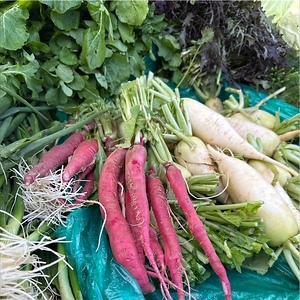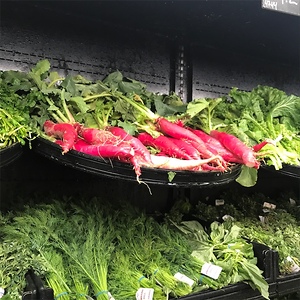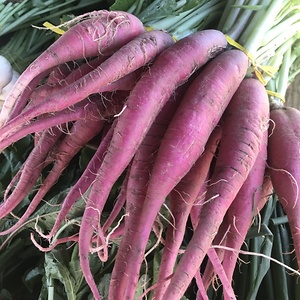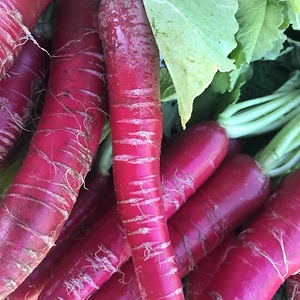


Cincinnati Market Radishes
Estimated Inventory, 24 ct : 0
Description/Taste
Cincinnati Market radishes are elongated, thin roots, averaging 15 to 17 centimeters in length, and have a straight, tapered shape, similar in appearance to a carrot. The roots have thin, red-pink skin with a semi-smooth and firm consistency, covered in fine root hairs. Underneath the surface, the flesh is dense, white, tender, and crisp with snap-like quality. Cincinnati Market radishes have a milder flavor than other varieties and offer a subtly sweet, earthy, and peppery bite. The roots also grow compact, leafy green tops that are also edible, bearing an herbaceous, vegetal, and pungent taste.
Seasons/Availability
Cincinnati Market radishes are available year-round.
Current Facts
Cincinnati Market radishes, botanically classified as Raphanus sativus, are an American heirloom variety belonging to the Brassicaceae family. The unique cultivar was once one of the most popular long radish varieties cultivated in the midwestern United States during the 19th century, but over time, round radishes became the favored radish, leading long radishes to fade from commercial production. In the modern-day, Cincinnati Market radishes are also known as Long Scarlet Cincinnati radishes and are a rare but easy-to-grow specialty home garden variety. The cultivar is fast-maturing, harvested in 30 to 35 days, and produces high yields of elongated, red-pink roots. The radishes can also be grown close together, making them suitable for small spaces and compact gardens, and are cultivated by radish enthusiasts for their mild flavor.
Nutritional Value
Cincinnati Market radishes are a good source of vitamin C to strengthen the immune system, potassium to balance fluid levels in the body, and folate to process carbohydrates into energy and assist in red blood cell production. The roots also provide fiber to stimulate the digestive tract, magnesium to control healthy nerve functions, calcium to protect bones and teeth, and contain lower amounts of copper, riboflavin, and manganese.
Applications
Cincinnati Market radishes have a mild, peppery flavor well-suited for both raw and cooked preparations, including roasting, sautéing, and braising. The radishes can be used fresh on vegetable platters, served with herbs-infused dips, or they can be sliced and tossed into green salads. Cincinnati Market radishes are often combined with other spring vegetables as fresh, crunchy side dishes, chopped into homemade salsa, used as a topping over tacos, or thinly cut and layered over toast. Beyond fresh applications, Cincinnati Market radishes can be braised and stirred into grain bowls, lightly cooked and sprinkled over omelets, roasted and served with meats, or mixed into soups. The radishes can also be quick-pickled and placed over sushi or sliced and combined into egg rolls. In addition to the roots, the radish tops can be blended into sauces such as pesto, finely chopped and floated over soups, or torn and tossed into salads. Cincinnati Market radishes pair well with carrots, sugar snap peas, cucumber, corn, avocado, yogurt, cheeses such as feta, chevre, and ricotta, and herbs including cilantro, thyme, dill, and tarragon. Fresh Cincinnati Market radishes will keep for a couple of weeks when wrapped in a damp paper towel and stored in a plastic bag in the refrigerator.
Ethnic/Cultural Info
During the late 19th century, Cincinnati Market radishes were once known as Cincinnati Glass radishes and Cincinnati Glass carrots. The scarlet variety obtained these names from their narrow, elongated, and tapered carrot-like appearance and were frequently grown in glass greenhouses and garden sheds throughout the Cincinnati area. With the variety’s increasing popularity and availability in markets, a legend was also created around the texture of the radish. Cincinnati Glass radishes were believed to have such brittle texture that the root could be easily snapped. This light, crisp consistency led many to consider the variety as delicate as glass, earning it the name Glass radish. Despite the whimsical nickname, over time, the 19th-century name was forgotten, and the variety reverted back to its original title as Cincinnati Market radish.
Geography/History
Cincinnati Market radishes were developed in the mid to late 19th century in the region surrounding Cincinnati, Ohio. During the 19th century, long radishes were a favored variety in American households and were often the most expensive in local markets. As a result, long radishes were extensively marketed and cultivated, including the short-topped scarlet radish, which was believed to be the parent variety of the Cincinnati Market radish. Short-topped scarlet radishes were first featured in Parkhurst Cincinnati Seed Warehouse’s catalog in 1835. While the exact date of when Cincinnati Market radishes were created is unknown, the variety was cultivated during the mid to late 19th century and was the product of years of selective breeding. Multiple Cincinnati seed catalogs also mentioned the Cincinnati Market radish as the preferred long radish variety in the late 19th century and was believed to have been widely grown through commercial growers and home gardeners throughout the city. Today Cincinnati Market radishes have largely fallen out of favor and are considered a rare variety found through select online seed catalogs grown in home gardens across the United States.
Recipe Ideas
Recipes that include Cincinnati Market Radishes. One














